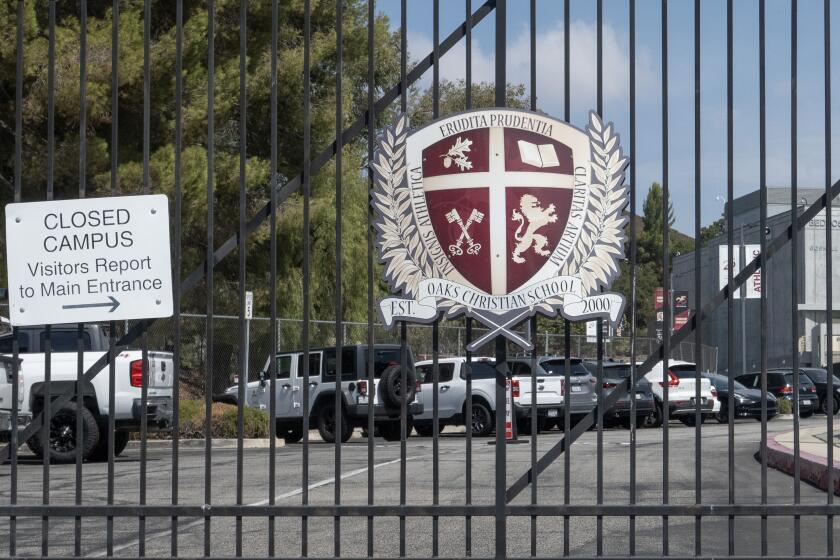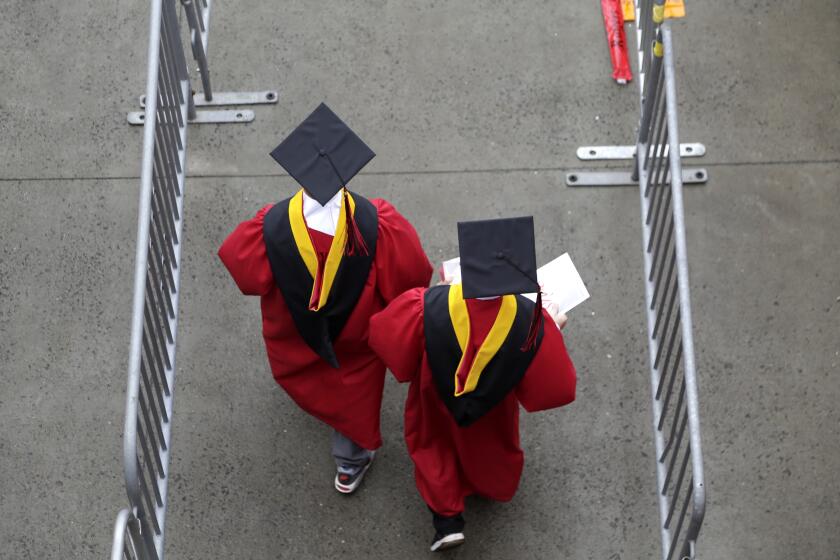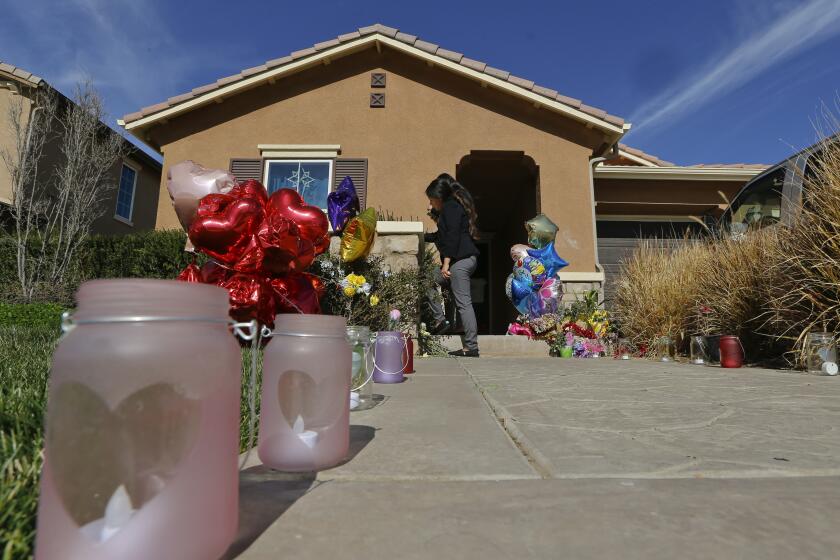Pomp and Aftershocks : After a Shaky Final Semester, CSUN Graduates Ready to Move On
To the strains of “Pomp and Circumstance,” armies of anxious college seniors across the country will march this spring from the security of campus life into the shaky and unpredictable outside world--except at Cal State Northridge, where it’s the reverse.
At the San Fernando Valley school, graduates began preparing Sunday to leave behind an institution literally shaken to its foundations, heading for more solid footing on the outside.
“I’ll never forget the last semester at Northridge,” said Maricar Lagman, 24, who was honored as the school’s outstanding engineering student during ceremonies recognizing about 1,000 of CSUN’s top graduates.
It is a sentiment no doubt common among the 6,700 CSUN students who will receive diplomas in ceremonies beginning today.
Lagman and her roommates started the semester sleeping huddled on the living room floor of their Northridge townhouse, afraid to sleep in their own rooms because of aftershocks from the Jan. 17 earthquake that caused an estimated $325 million in damage to the CSUN campus. She recalled being jolted out of bed by the quake, groping her way outside without shoes or glasses, and injuring her ankle and hand when she tripped over a moped in the darkness.
“I was scared for my life. I just wanted to get out, out of California,” said Lagman, who now hopes to find work as a computer software engineer, but has resigned herself to a continued life in the seismic zone.
She and thousands of others, however, decided to stick it out--despite broken buildings, including the library, broken laboratories, temporary toilets and classes in trailers.
At the beginning of the semester, classrooms were mismarked, keys didn’t work and professors had no access to lecture notes locked away in buildings closed by safety inspectors. Not even the drinking fountains worked.
“All the students have been through a lot,” said Lagman. “I think we’ve learned a lot, and I’ve grown a lot.”
Lagman and other grads have discovered early one of the most important and lasting lessons of college life: endurance. That and the need to cooperate, “to find the common ground of humanity,” said keynote speaker Andrew Young.
Young--the civil rights leader, former mayor of Atlanta and former U. N. ambassador--said he learned the first lesson in 1963, when he and a group of young protesters were locked in a van by Georgia police.
“The 110-degree heat was designed to make us lose our cool and give up our struggle,” said Young, vice chairman of an engineering firm that has been hired to assess damage at the CSUN campus.
Instead of panicking, he said, the group visualized a day at the beach, imagining the feel of cold water, the lap of the waves “until the police gave up and let us out.”
The 25,000 or so students at the campus faced their own tests of will after the Northridge quake damaged most of the university’s largest buildings just before the start of the spring semester.
In a round-the-clock effort, portable classrooms, trailers and toilets were rented and set up between damaged buildings to keep the school open. But the arrangement, praised as heroic, brought with it a host of problems for students and faculty alike.
“My music classes ended up all over the place, and I was running back and forth across the campus,” said Audra Camacho, 18, a freshman clarinet player in the CSUN wind ensemble that played music for the honors student ceremony. “The teachers thought they’d take it easy at first, and we talked a lot about the earthquake and stuff, but then we had to make up all the material later, for finals.”
Camacho said she plans to return for her sophomore year in the fall, even though it will be from three to five years before CSUN is completely rebuilt.
Although federal money is expected to eventually pay for most repairs to the school, some students are apparently reluctant to spend their college years at a campus under construction. Applications to transfer into CSUN for the fall semester are down slightly from previous years.
As a result, campus officials are stepping up efforts to contact local high schools and community colleges to assure students that they can enroll at CSUN, despite its troubles.
CSUN President Blenda J. Wilson said she was pleased that despite the earthquake “students did not desert us.” The earthquake, she said, “gave us a profound sense of our potential, united us around our dedication to education.”
Aides say the earthquake also in some ways made it easier for Wilson--who took over the top job 20 months ago--to push through management changes at the school, which has been criticized in the past for its low graduation rate.
Most of the top administrators under the previous CSUN president, James Cleary, are either gone or working in different jobs. Campus officials said Sunday that Elliot Mininberg, vice president for administration and finance, is resigning his post after 10 years to become a professor in the School of Education.
But campus politics, or even an earthquake for that matter, had little effect on graduate Anne Marenco, a 35-year-old Santa Clarita resident and mother of two who is getting a bachelor’s degree in family environmental sciences, formerly home economics.
For 18 years, Marenco has plugged along toward a degree, taking classes part time at Pierce College before arriving at CSUN in 1983.
Marenco said she plowed through the spring semester undaunted by the destruction at her campus. In fact, Marenco, like others, said classes were easier because many instructors lightened up on their usual assignments.
‘I’m generally a very flexible person, and didn’t feel put out about having classes in a trailer or having to go to the bathroom in a trailer,” said Marenco, who plans to spend the next two years at CSUN working on a master’s degree.
“I would have hated to have the university say, ‘OK, we’re closed.’ I think after this semester, I feel a greater attachment to this university,” she said. “We all worked very hard this semester to make it bearable and livable.”
More to Read
Sign up for Essential California
The most important California stories and recommendations in your inbox every morning.
You may occasionally receive promotional content from the Los Angeles Times.










